Statement on Monetary Policy – February 2018 1. International Economic Developments
There was a broad-based pick-up in global economic growth in 2017. The Chinese economy continued to grow at a solid rate. GDP growth increased in the major advanced economies, from rates that were already above estimates of potential growth. Global merchandise trade picked up, which contributed to higher growth in the trade-exposed east Asian economies. The strength of the global expansion in 2017 surprised most economic forecasters, and forecasts for 2018 have been revised up over the past year (Graph 1.1). Global growth is expected to be sustained at around recent rates over the next couple of years, supported by accommodative monetary policies as well as more expansionary fiscal policy in the United States. However, most economic forecasters expect growth to ease in the longer term; for example, population ageing is expected to weigh on economic growth in a number of regions. In China, policies to control financial risks could also lead to slower GDP growth through tighter financial conditions.
Investment growth and business confidence were notably stronger in 2017 in many economies, following several years of weakness. Growth in industrial production, merchandise trade and manufacturing business conditions reached their highest levels in a number of years (Graph 1.2). The upswing in industrial activity, driven by the production of capital and intermediate goods, has been broad based across economies. Financial and geopolitical risks in the euro area have eased, which has also contributed to the increase in confidence. Consumer confidence is high and household incomes have been supported by strong employment growth in most advanced economies; consumption growth has been above average for a number of years.
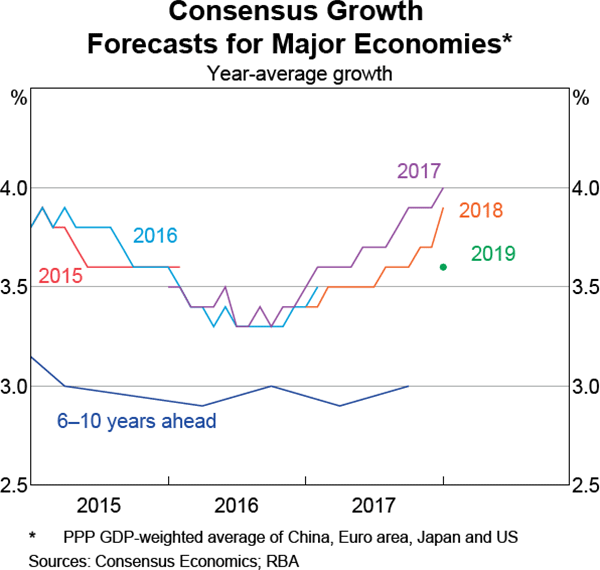
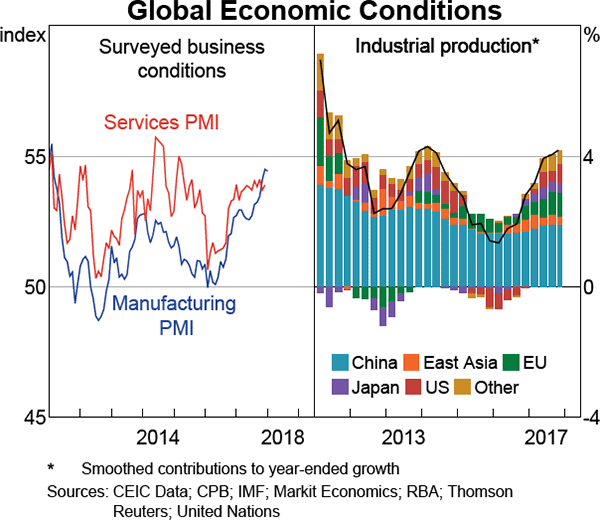
Spare capacity has diminished further, with many economies growing at rates above potential growth. In particular, unemployment rates in a number of advanced economies have declined to multi-decade lows and are a bit lower than most estimates of full employment. Yet wage growth and core consumer price inflation globally have remained subdued to date (Graph 1.3). Some pick-up in inflation is expected over the next year or two. Oil and other commodity prices have increased, which has contributed to a broader build-up of price pressures on the producer side. Inflation expectations have also increased over the past year as spare capacity has diminished further.

China and Asia-Pacific
In China, GDP growth remained solid in 2017. Growth was supported by fiscal spending and continued rapid growth in aggregate financing. Consumption continued to be the main driver of growth in the year, and net exports contributed as global economic conditions improved further (Graph 1.4). Growth in investment slowed overall, which reflected a softening in property and manufacturing investment growth, while public spending on infrastructure was resilient up until the closing months of the year. At the Central Economic Work Conference, which was held in mid December, the Chinese Government signalled continuity in economic policy for 2018. It also reiterated the focus on controlling financial risks and the growth of debt, eliminating excess capacity, supporting industrial upgrading, and reducing pollution.
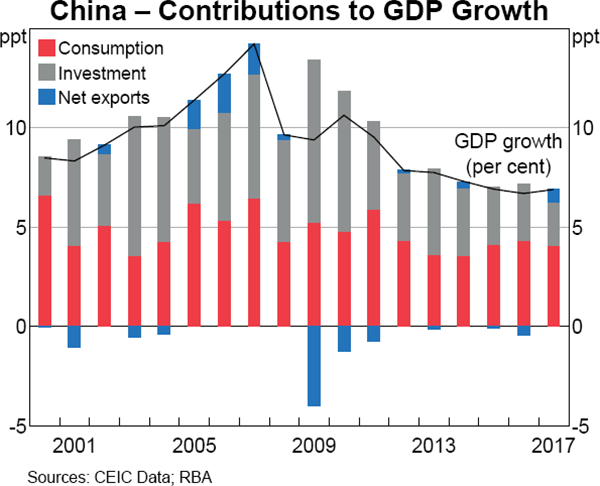
On the production side of the economy, the services (tertiary) sector continued to be the main contributor to growth. In the industrial sector, overall growth in production has been stable, but a range of other indicators suggest some softening of conditions (Graph 1.5). Output declined for a large number of industrial products towards the end of 2017; growth in revenues and profits has eased in numerous manufacturing sub-industries in recent months. The easing in industrial conditions can be partly attributed to environmental policies that restricted output in a range of heavily polluting industries in 28 cities during China's winter months. The steel sector experienced noticeably weaker activity as a result of these restrictions, which were implemented from late October; iron ore imports (including from Australia) have been relatively steady in recent months, but Chinese iron ore production has declined significantly.
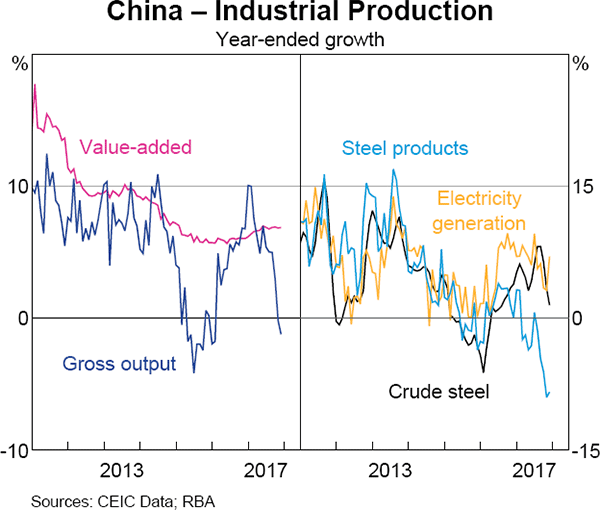
To cut pollution and reduce dependence on coal-fired power, the Chinese authorities have also taken measures to encourage firms and households to switch to gas (including by reducing gas prices for business use). Increased gas demand was partly met by strong growth in liquefied natural gas imports in 2017. Subsequent reports of some households experiencing freezing conditions due to gas shortages prompted authorities to relax restrictions on the use of coal for heating in certain locations. In December, the government released a plan to phase out 70 per cent of coal-fired heating systems in northern Chinese cities by 2021 and announced a plan to develop a nationwide carbon trading scheme in the next couple of years.
Inflation in China rose a little over the past few quarters, partly driven by higher fuel prices. Core inflation (which excludes food and energy prices) has edged higher since early 2016 and has been supported by upstream price pressures and continued policy accommodation. However, headline inflation remained below the authorities' upper bound of 3 per cent in 2017. Producer price inflation was elevated over 2017, partly reflecting the pick-up in commodity prices, as well as more recent supply cuts due to environmental restrictions on output. Producer price inflation eased towards the end of the year, consistent with slower growth in economic activity.
Housing price inflation in China has continued to ease in recent quarters (Graph 1.6). The authorities have tightened restrictions on housing purchases and loan-to-value ratios over the past year. Indicators of residential activity remain subdued; growth in sales and residential investment have moderated. Recent policy statements suggest that the central government continues to be focused on discouraging speculative real estate investment while supporting investment in rental accommodation and the renovation of unused commercial property for residential rental use.

Total social financing grew by 12 per cent in 2017, which is consistent with the target set by the State Council. Estimates of the non-financial sector debt-to-GDP ratio therefore rose over the year (Graph 1.7). Financing for the corporate sector continued to grow broadly in line with GDP over 2017, but corporate borrowers have substituted towards more traditional financing channels in response to tighter regulation of financing outside the formal banking system. Household credit expanded at a rapid pace over 2017, despite slower growth in mortgage borrowing in response to constraints on property purchases and borrowing. Government debt also grew strongly, reflecting continued support for public investment. Average nominal bank lending rates have remained relatively low, although they did edge higher in 2017.

In recent months, the authorities have taken additional measures to tighten financial regulation and strengthen oversight of ‘shadow banking’ activity (see ‘International and Foreign Exchange Markets’ chapter). Financial regulators jointly published updated rules for the asset management industry (a central part of the ‘shadow banking’ sector). These rules, which are scheduled to be implemented in 2019, aim to make regulations more consistent across financial institutions, reduce opportunities for regulatory arbitrage and improve risk management. Additional measures have also been announced that aim to increase oversight of entrusted lending (a form of inter-company financing in which banks act as agents) and a range of smaller ‘shadow banking’ activities, including internet-based loan finance.
GDP growth in east Asia (excluding China and Japan) increased to around its post-crisis average in late 2017, reflecting the recovery in growth of the high-income economies in the region (Graph 1.8). The upturn in global trade over 2017 supported this recovery because many of these economies are closely integrated in global production chains. The electronics sector – particularly the semiconductor industry – has played an important role in the recovery and was buoyed by strong demand from China to meet both Chinese domestic demand and demand for inputs into global production chains. Strong semiconductor demand has also boosted business investment, but has had little effect on employment growth because the industry is not labour intensive and has only weak connections to other domestic industries. Nonetheless, the overall improvement in economic conditions has contributed to stronger consumer confidence and retail sales growth in some of the higher-income economies in the region; this is likely to support consumption and near-term growth more broadly. In the middle-income east Asian economies, private consumption growth has continued to be resilient. Across the east Asian region, headline and core inflation remain subdued. Overall, monetary and fiscal policies remain accommodative and were little changed over the past year.
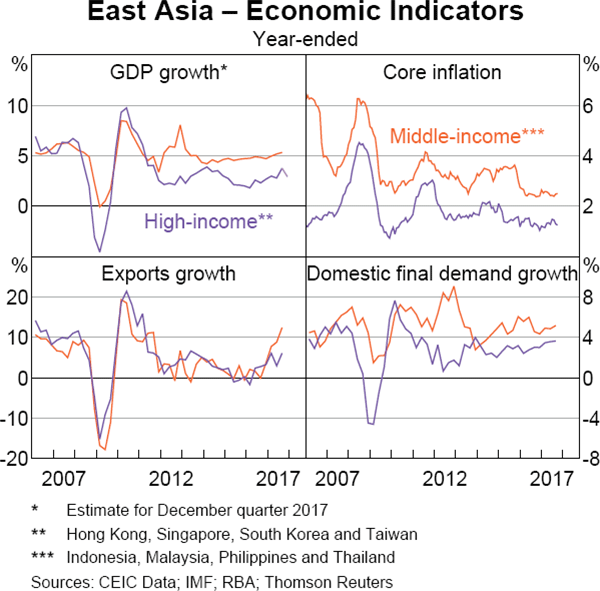
In India, GDP growth has moderated over the past couple of years, to around 6 per cent (Graph 1.9). Growth in private investment was subdued; a contributing factor has been weak supply of credit from state-owned banks, which have been constrained by high levels of bad debt in recent years. The Indian Government's recapitalisation plan for state-owned banks over the next two years is therefore expected to support investment. CPI inflation has picked up since mid 2017 – partly because food price inflation and housing rent allowances for public sector employees have both increased – to be above the Reserve Bank of India's medium-term inflation target of 4 per cent. Inflation may ease in coming months, however, following a decision by India's Goods and Services Tax Council to revise down tax rates on a broad range of items.
New Zealand GDP growth was around its long-run average over 2017 (Graph 1.10). Strong population growth has sustained private consumption growth. However, growth in both residential investment and housing prices eased over 2017. Housing market developments have been influenced by the tightening of loan-to-value and investor housing lending restrictions in 2016 by the Reserve Bank of New Zealand (RBNZ), as well as supply constraints in the construction sector. More recently, the RBNZ announced some easing of its loan-to-value lending restrictions, and there has been a modest pick-up in residential investment growth and building approvals. Accommodative monetary policy, as well as increased government spending announced by the recently elected government, should also support growth in the period ahead.
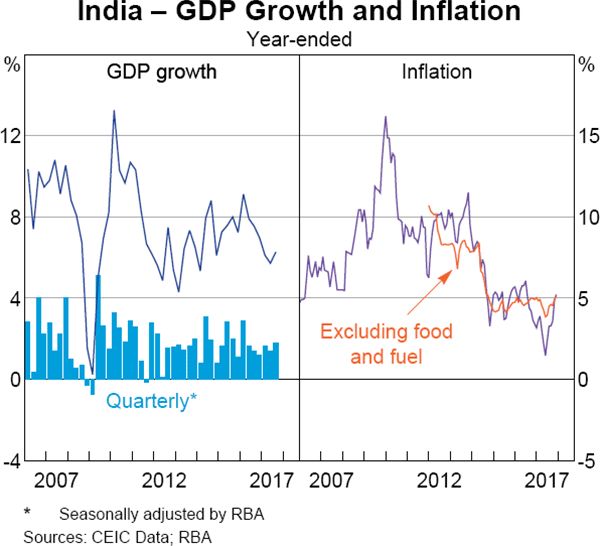
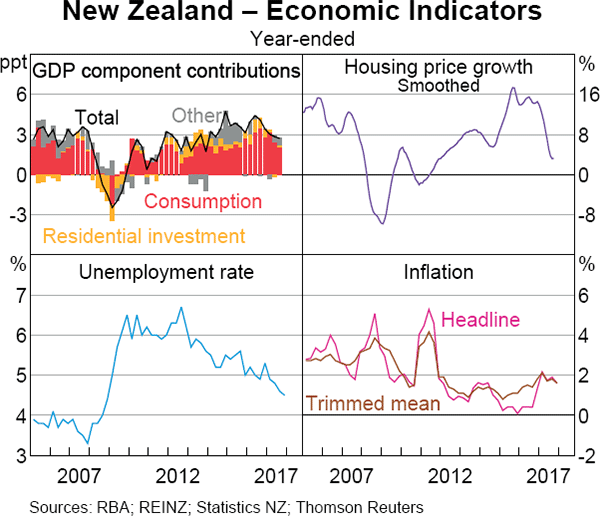
The supply of labour has grown strongly in New Zealand, driven by high net immigration and a marked rise in the participation rate. Employment growth remains very high and the unemployment rate has declined to its lowest level since 2009. Nominal wage growth remains subdued, however, and growth in labour productivity has been weak. Inflation has increased over the past two years and is close to the RBNZ's target.
Major Advanced Economies
GDP in the major advanced economies grew faster than estimates of potential growth over 2017, partly driven by stronger business investment growth (Graph 1.11). In the euro area, GDP growth has increased to its highest rate since 2011 and the increase has been broad based across the member countries.
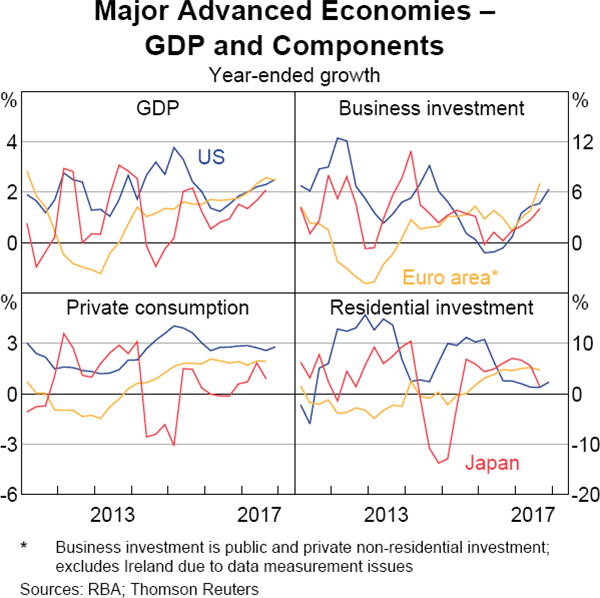
Growth in the major advanced economies is expected to continue to exceed potential over the next two years, which should ultimately lead to higher inflation. Monetary policy has been supporting growth for nearly a decade and is expected to remain expansionary even as some central banks move to a less accommodative stance. Fiscal policy has become less contractionary over the past year or two, particularly in the United States, and this has also supported growth (Graph 1.12). The recent tax changes in the United States will boost activity over the next two years, although the expected consumption tax increase in Japan in late 2019 is likely to subtract from growth there in the subsequent year.
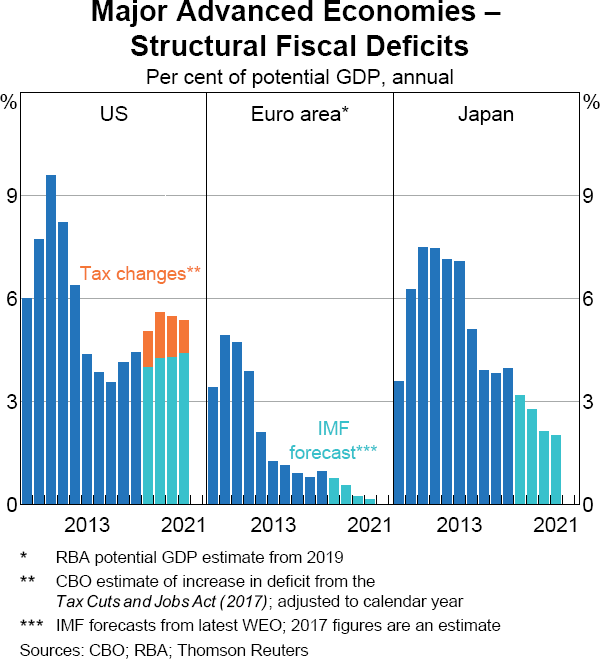
Business investment picked up across the major advanced economies over 2017, to be above long-run average growth rates; however, investment remains below its pre-crisis level in the euro area. Machinery and equipment investment has been the main driver of this growth. A range of indicators point to continued strong business conditions, particularly in manufacturing, and investment intentions are especially elevated in the United States, partly owing to the recent tax changes (Graph 1.13).
Household consumption growth remained at above-average rates in the United States and the euro area over 2017, and recovered somewhat in Japan. It has been supported by robust employment growth as well as a modest pick-up in wage growth. This should continue – and even strengthen – in the period ahead as labour markets tighten further. In the United States, the reduction in personal income taxes should also boost consumption growth over the next couple of years. Residential investment growth has eased across the major advanced economies, although it remains above its long-run average rate in the euro area. In the United States, housing market activity picked up in the December quarter, in part reflecting rebuilding after hurricane-related damage in the previous quarter.
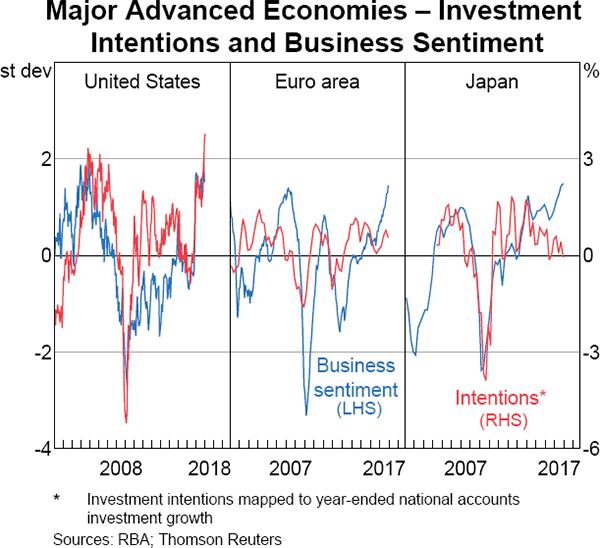
Labour markets in the major advanced economies have tightened significantly over recent years. Unemployment rates are at multi-decade lows in the United States, Japan and some European economies (such as Germany and the United Kingdom). For the euro area in aggregate, the unemployment rate has declined to a nine-year low; the decline has been broad based, but unemployment rates vary significantly across the member states. Unemployment rates in the major advanced economies have fallen to below the rates consistent with most estimates of full employment (the non-accelerating inflation rate of unemployment or NAIRU). The NAIRU estimates are subject to significant uncertainty, however, and have been repeatedly revised lower since 2012 for a range of advanced economies as actual unemployment rates have declined without inflation picking up (Graph 1.14). The modest pick-up in wage growth and continuing subdued inflation may indicate that there is more spare capacity than is implied by the current NAIRU estimates.
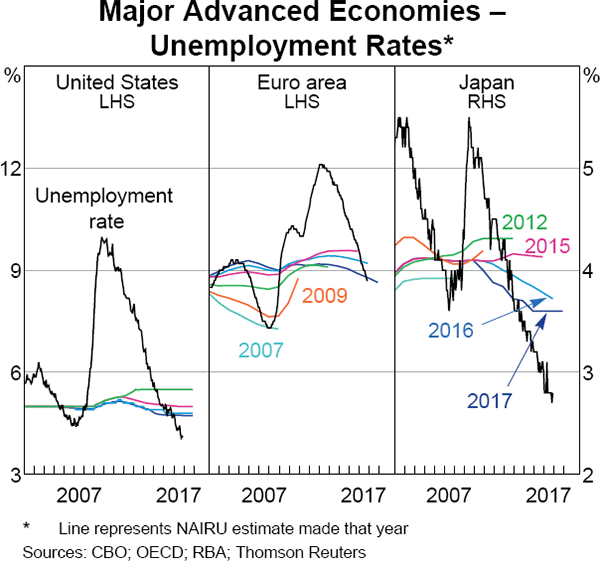
A range of other measures suggests that labour markets are tight (Graph 1.15). Survey measures of employment conditions have reached record highs across the major advanced economies. Job vacancies (as a ratio to the number of unemployed) have increased strongly in the United States and Japan, where they are around record highs. The vacancy ratio has increased only a little in the euro area, but is high relative to its history. Participation rates have increased in Japan, supported by increasing female participation, and have been little changed in the euro area and the United States at a time when population aging might have been expected to induce declines. Underemployment rates have also been declining. In the United States and Japan they have fallen to below or around their pre-crisis troughs, but underemployment remains elevated in the euro area suggesting that there may be more spare capacity there than indicated by the unemployment rate.
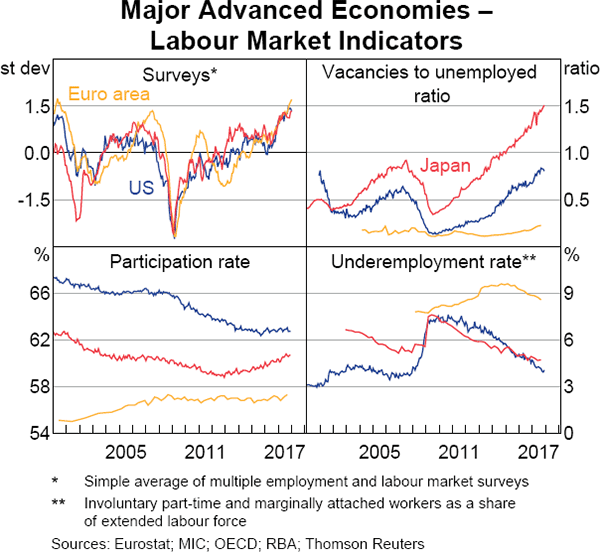
Wage growth has picked up a little across the major advanced economies over recent years, but it is well below its pre-crisis average in the euro area (Graph 1.16). In Japan, the increase in wage growth has been most pronounced in the more flexible part-time sector. One reason for the limited pick-up in wage growth might be that labour productivity growth has been slow for many years in these economies.

With significant wage pressures yet to emerge, core inflation has remained low in the major advanced economies (Graph 1.17). Core inflation fell noticeably in the United States in 2017, although this largely reflected temporary factors. Core inflation has increased a little in recent months in the United States and Japan and has been steady in the euro area. Headline inflation was higher in 2017 in all three economies, driven by higher oil prices. Market measures of inflation expectations are above their post-crisis troughs and have increased a little further recently. Consumer inflation expectations have been steady in the United States and Japan, but have increased in the euro area over the past year. As spare capacity diminishes, central banks in the major advanced economies expect inflation to increase towards the central banks' targets over the next few years.

Economic developments in the United Kingdom have differed from those in the major advanced economies over the past year or so. GDP growth slowed a little and inflation has picked up strongly due to the depreciation of the pound following the Brexit vote. As a result, real wage growth has fallen sharply and was negative for most of 2017, consumer confidence declined to be below average and consumption growth has slowed. Growth in business investment has also eased, despite relatively strong conditions in the manufacturing sector owing to the pick-up in global trade and the exchange rate depreciation. Uncertainty about the future EU–UK relationship and the higher cost of imported investment goods are likely to be constraining investment. Despite these developments, the labour market has remained tight and reports of difficulties in recruiting suitable labour are becoming increasingly widespread.
Commodity Prices
Global commodity prices were generally higher over recent months, led by bulk commodity prices, reflecting continued strength in demand and a range of supply-side factors (Graph 1.18). The spot price of iron ore has rebounded, coking coal prices have increased significantly and oil prices have continued to rise (Table 1.1). Rural prices are slightly higher, while base metals prices continue to be supported by the improvement in global economic conditions and reduced supply following production cuts in China. As discussed in the ‘Economic Outlook’ chapter, Australia's terms of trade are expected to decline over the forecast period, consistent with lower Chinese demand and further increases in low-cost supply of bulk commodities. However, there is a risk of some near-term volatility given the interplay between demand for steel, environmental restrictions in China and temporary supply disruptions.
The spot price of iron ore has increased sharply since the previous Statement, retracing the decline over the previous quarter (Graph 1.19). Prices have been supported by Chinese import demand, which has remained at a high level despite cuts to steel production in a number of Chinese regions for environmental reasons; constraints on heavily polluting activities are expected to remain in place until mid March. Elevated Chinese steel prices have also reportedly increased expectations that steel production, and therefore demand for iron ore, may increase after winter. There continues to be a large premium for higher-quality iron ore products, partly because Chinese steel producers are trying to minimise pollution by favouring high-quality iron ore.
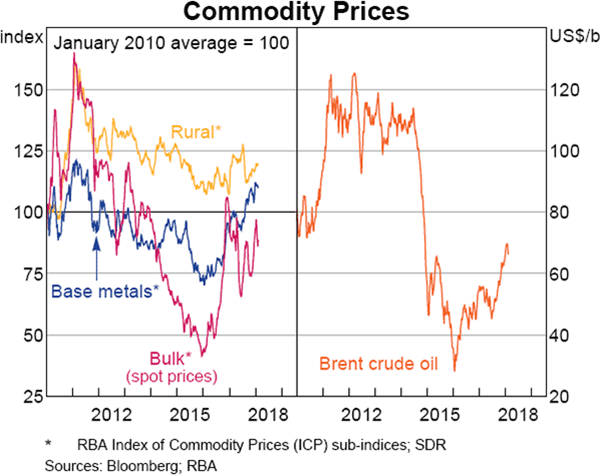
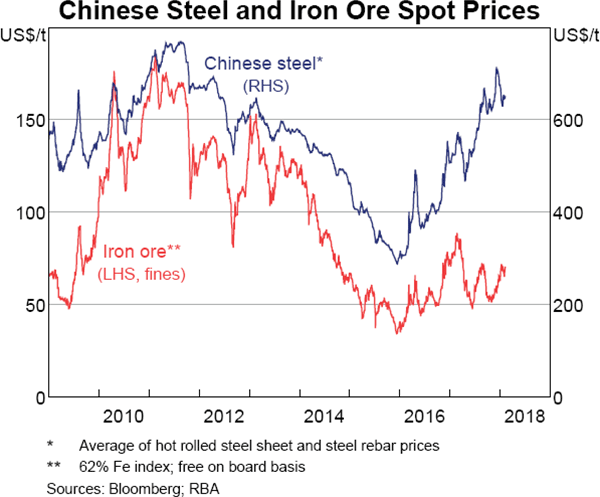
The spot price of hard coking coal has also increased notably since the previous Statement, partly because congestion and maintenance at key ports in Queensland has constrained supply (Graph 1.20). The spot price of thermal coal is slightly higher since the previous Statement. Prices have been supported by a number of factors over the past few months, including industrial disputes at mines in New South Wales and strong global manufacturing activity. More recently, prices have also been supported by demand from China, after authorities relaxed import restrictions on thermal coal following gas shortages.
| Since previous Statement | Over the past year | |
|---|---|---|
| Bulk commodities | 19 | 2 |
| – Iron ore | 24 | −16 |
| – Coking coal | 20 | 24 |
| – Thermal coal | 3 | 24 |
| Rural | 2 | 0 |
| Base metals | 1 | 13 |
| Gold | −1 | 0 |
| Brent crude oil(b) | 3 | 21 |
| RBA ICP | 11 | −2 |
| – Using spot prices for bulk commodities | 11 | 3 |
|
(a) Prices from the RBA Index of Commodity Prices (ICP); bulk commodity prices are spot prices Sources: Bloomberg; IHS; RBA |
||
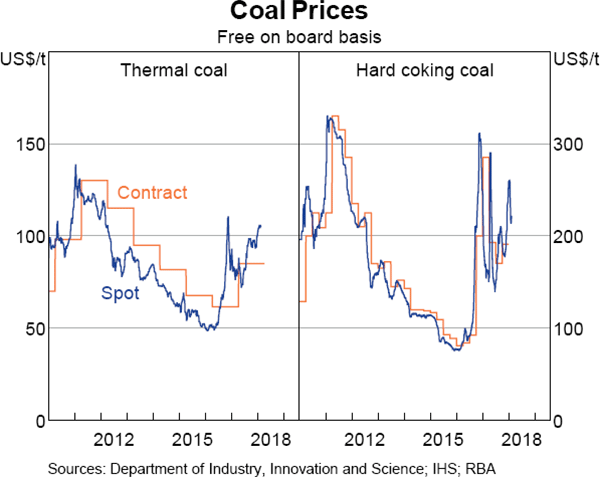
Oil prices increased to their highest level in over three years, but have eased recently. Prices were supported by an agreement between the Organization of the Petroleum Exporting Countries (OPEC) and non-OPEC countries to extend the production cap, as well as the improvement in the near-term outlook for global oil demand.